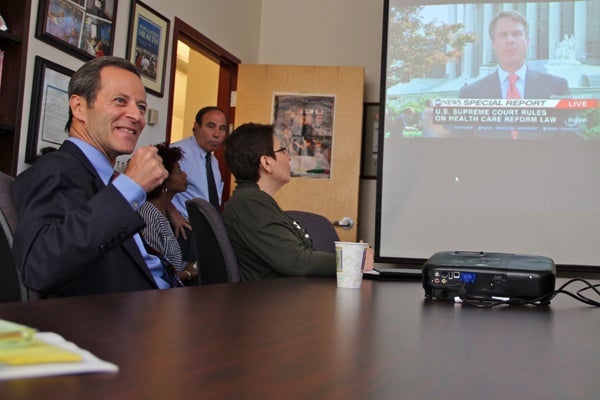ACA decision leaves health consumers with more questions
-

-

-

-

-

The United States Supreme Court building in Washington, D.C.
-

-

-

-

-

-

-

-

About 20 faculty members and students gathered around a conference table at the Jefferson School of Population Health Thursday morning to watch the Supreme Court ruling on the Affordable Care Act on TV. The decision was greeted with applause — and surprise.
When asked if Thurday morning’s announcement is what they expected, not a single person raised his or her hand.
The school’s dean Dr. David Nash, a health policy expert, said, “Right now we feel pretty good that the constitutional issue has been resolved. The law in a torturous way has been upheld, and as best as we can tell at 5 after 10, it’s full steam ahead for all of the delivery system reforms that are already moving ahead too. So this is great news, great news.”
The tone was completely the opposite at a Tea Party press conference on Independence Mall this morning. Many conservatives are using the Supreme Court decision as a rallying cry for GOP wins in November.
The initial reaction of John Sullivan, a Cherry Hill, N.J., Tea Party member and attorney: “That is fiscally irresponsible.”
“While they have not approved the mandate from a moral, ethical or substantive standpoint today,” Sullivan said, “they’ve recognized that it is not the judiciary’s role to interfere with legislative decisions, and that’s why it is so important in November that we put in a new Congress, a new House, a new Senate, that is comprised of people that are fiscally responsible.”
Aside from the political maneuvering, reactions are mixed among regular people out on the street. Even though this law passed more than two years ago, and some of its measures have already gone into effect, people still have a lot of questions about how the legislation will affect them.
Jefferson student Crystal Hatton had a question about the requirement for her to buy insurance that will go into effect in 2014. “Right now, as a student, I don’t have insurance,” Hatton said. “I can’t afford it right now, so my main concern is how much it will be. I definitely don’t want to be charged a penalty.”
Kristen Dama, a staff attorney at Community Legal Services in Philadelphia, said there is some support written into the law for people like Hatton.
“For low income people and families between 133 percent of the federal poverty guidelines and 400 percent of the federal poverty guidelines, there are going to be subsidies and credits from the federal government that make insurance affordable for them,” Dama said.
Here are the nuts and bolts: If you make 133 percent of the poverty line — that’s about $15,000 a year for an individual — the maximum premium you’ll have to pay is around 3 percent of your income.
Subsidies will continue up to 400 percent of the poverty line — that’s an income of about $45,000 dollars a year, using 2012 income guidelines. People earning that much would have to pay 9.5 percent of their income.
Either that, or pay a fee. It starts lower, but rises up to almost $700 or a percentage of your income, whichever is higher, by 2016.
Some people like Wildwood, N.J., resident Ken Oeffler, 56, want to know what will happen for people who already have insurance offered through their employers. Will their premiums go up?
“My largest concern is what is it going to cost me?” Offler said. “How much is my insurance going to go up?”
Sam Marshall, a lobbyist for Pennsylvania insurance companies, argued that it’s too soon to tell. But he said the primary focus of this law was not to reign in the ballooning costs of health care.
“This was a law designed to get more people covered,” Marshall said. “It wasn’t a law to make health care — and therefore health insurance — cheaper. That’s always been acknowledged as the next step.”
Marshall said aside from ever-rising medical costs, whether premium prices and cost-sharing go up due to the law depends a lot on the required benefits package — what must be covered under any plan — which the federal government has yet to name.
He said we also have to see how effective the “individual mandate” is at getting young, healthy people to buy insurance, rather than pay a fee or dodge both fee and coverage.
Some of the law’s most popular provisions are already in place and will now stick around — some free preventive services, continued coverage for adult children up to age 26, and no lifetime coverage limits.
And starting in 2014, adults cannot be denied coverage for pre-existing conditions, and women will have to be charged the same premiums as men for the same insurance coverage.
WHYY is your source for fact-based, in-depth journalism and information. As a nonprofit organization, we rely on financial support from readers like you. Please give today.

